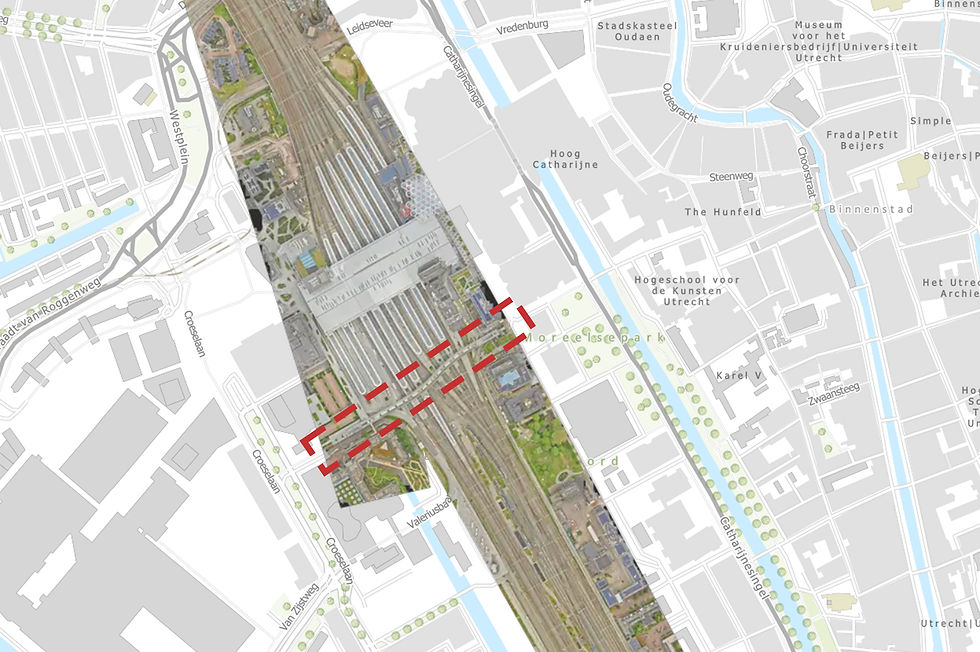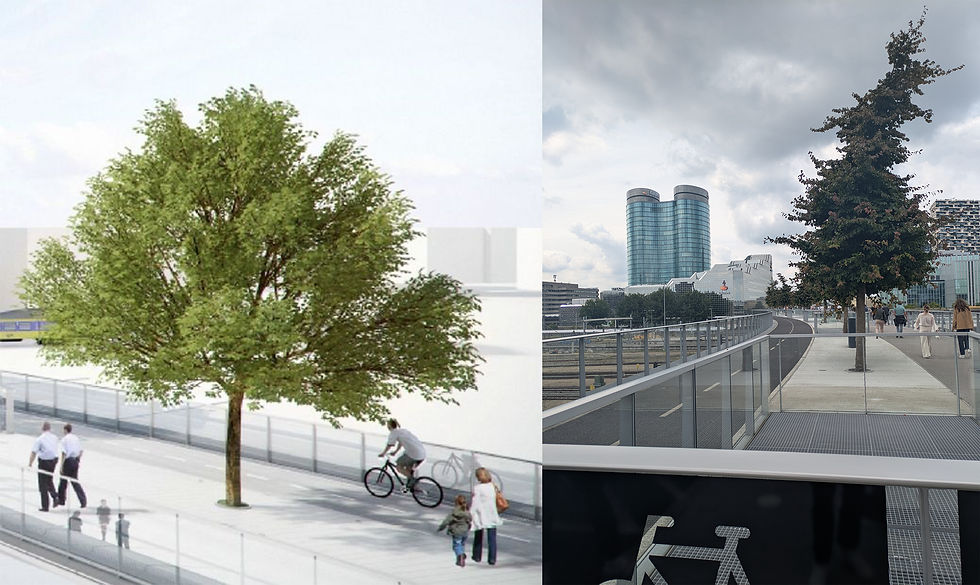Moral of the Moreelsebrug: creating Liminal Spaces
- TOPOS

- Sep 23
- 4 min read
Column by Pim Buijs

Figure 1: The Moreelsebrug (Source: Jannes Linders in Cepezed, n.d.)
When I work at the city office in Utrecht, I often take a walk along the canal during lunch. Usually, I take the stairs just before the entrance to Hoog Catharijne, but sometimes I take the Moreelsebrug (figure 1). This bridge crosses the railway lines at Utrecht Central and connects the two sides of the station area. It's a place that always leaves a strange impression on me: why is there a bike path here if almost no one uses it? Why are the trees in such bad shape? And what are those strange metal racks that hang right above each train platform?
When I was asked to write a column about liminal spaces, the Moreelsebrug was the first place that came to mind. A liminal space is a transitional area between two defined places, often evoking a uneasy feeling. These are often in-between places without much meaning, meant to be passed through. That description aligns with the feeling the Moreelsebrug gives me. But is that perception justified?
A Brief History Lesson
The Moreelsebrug is part of the development of the area around Utrecht Central Station. Completed in 2016, the Moreelsebrug connects Croeselaan (on the side of the Beurskwartier and Jaarbeursplein) with the Laan van Puntenburg (near the Catharijnesingel and the old city center) (figure 2). The purpose of the Moreelsebrug is to create a faster cycling and walking route between the old city center and the station area. Given that goal, it would be easy to label the bridge as a liminal space: the point of the place is to connect two other places. People don’t go there to linger, but to pass through.

Figure 2: Location of the Moreelsebrug (Source: ProRail, 2025)
According to the plans, the bridge was also built for another purpose: to provide an additional connection to the train platforms of Utrecht Central, in order to relieve pressure on the main station hall. Both NS and the city council supported this idea, aiming to reduce crowding and ensure safety. However, these plans were thwarted by the owner of Hoog Catharijne. To get from the old city center to the station and vice versa, pedestrians currently must pass through Hoog Catharijne. With stairs leading directly to the platforms from the bridge, that detour would no longer be necessary—costing Hoog Catharijne potential customers.
This led to a series of lawsuits starting in 2015 and a delay in constructing the stairs (Duic, 2015; Duic, 2017). The bridge was built with the potential to add stairs later—hence the large metal racks above the platforms. Eventually, a judge ruled that the safety of travelers outweighed the commercial interests of Hoog Catharijne. Recently, it was decided that the stairs will be built; they are scheduled to be completed in 2028 (Duic, 2025). Perhaps the bridge evokes a sense of alienation because it isn’t finished yet?
Another element dropped during the planning of the Moreelsebrug was the inclusion of small conveyor belts for bikes, so cyclists could easily push their bikes up the bridge. These were scrapped due to budget cuts, making the bridge far less appealing to cyclists (Van Rossum du Chattel, 2024). Is the Moreelsebrug a liminal space because an essential component was cut for cost reasons?
Symbolic Trees
Another aspect of the Moreelsebrug that gives me an unsettling feeling is the trees planted on it. On paper, it’s a lovely idea: the station area is covered with bricks and concrete, and trees on a bridge are quite unique. However, when you actually see the trees on the Moreelsebrug, you begin to understand why this idea isn’t often executed:

Figure 3: The trees as planned (Source left: Cepezed in Van Rossum du Chattel, 2024) versus the actual trees (Source right: Pim Buijs)
NS imposed strict requirements for these trees: no leaves or excess water were allowed to fall onto the tracks below, and the trees absolutely couldn’t topple over. These are reasonable demands—after all, the tracks of the Netherlands’ largest train station lie underneath. The tree supplier assured everyone that the trees could withstand all weather conditions and would grow into beautiful specimens (figure 3). But these turned out to be empty promises: anyone who looks now will see 17 pitiful, crooked, and wilting trees (Van Rossum du Chattel, 2024). The idea was nice, but the trees offer little real value and cost a lot of money to maintain. You could call them symbolic trees. Is the bridge a liminal space because the trees never grew into what was envisioned?
Expectation vs. Reality
The answer to why the Moreelsebrug feels like a liminal space is now quite clear to me: the bridge is unfinished and not what the original plan intended it to be. The Moreelsebrug is therefore a good example of how reality can transform a well-intentioned plan into a liminal space. What was meant to be a smooth cycling and walking route between two vital parts of the city, adorned with green trees, has ended up as an empty, uneasy place.
This example clearly illustrates how our planning can be harshly confronted by reality—and that’s not a bad thing. Often, we create plans full of symbolism and grandeur, while ignoring practical feasibility. Only when those plans are put into action does the symbolism that gives a place value start to leak away through avoidable practical issues. To avoid liminal spaces, we must bring a healthy dose of realism back into our planning—consciously choosing which values we want to realize and committing to them. Because liminal spaces don’t typically arise by themselves—they result from a lack of realism. So it’s not the place that’s at fault, but us as its makers.
References
Cepezed, n.d. Moreelsebrug. https://www.cepezed.nl/nl/project/moreelsebrug-utrecht/12677/
Duic, 2015. Gemeente Utrecht en Klépierre tegenover elkaar in rechtszaal om perrontrappen Moreelsebrug. Duic. https://www.duic.nl/algemeen/gemeente-utrecht-en-klepierre-tegenover-elkaar-in-rechtszaal-om-perrontrappen-moreelsebrug/
Duic, 2017. Hoog Catharijne verliest slag in strijd om perrontrappen. Duic. https://www.duic.nl/algemeen/hoog-catharijne-verliest-slag-om-perrontrappen/
Duic, 2025. Gemeenteraad Utrecht stemt in met trappen vanaf Moreelsebrug naar perrons. Duic. https://www.duic.nl/politiek/gemeenteraad-utrecht-stemt-in-met-trappen-vanaf-moreelsebrug-naar-perrons/
ProRail, 2025. ProRail luchtfoto. https://luchtfoto-prorail-nl.pages.dev/
Van Rossum du Chattel, 2024. Windkracht 10-garantie niet waargemaakt: zo blijft Utrechtse boombrug voor problemen zorgen. RTV Utrecht. https://www.rtvutrecht.nl/nieuws/3727367/windkracht-10-garantie-niet-waargemaakt-zo-blijft-utrechtse-boombrug-voor-problemen-zorgen







Comments